Indigenous
What Food Is Indigenous to North America ?
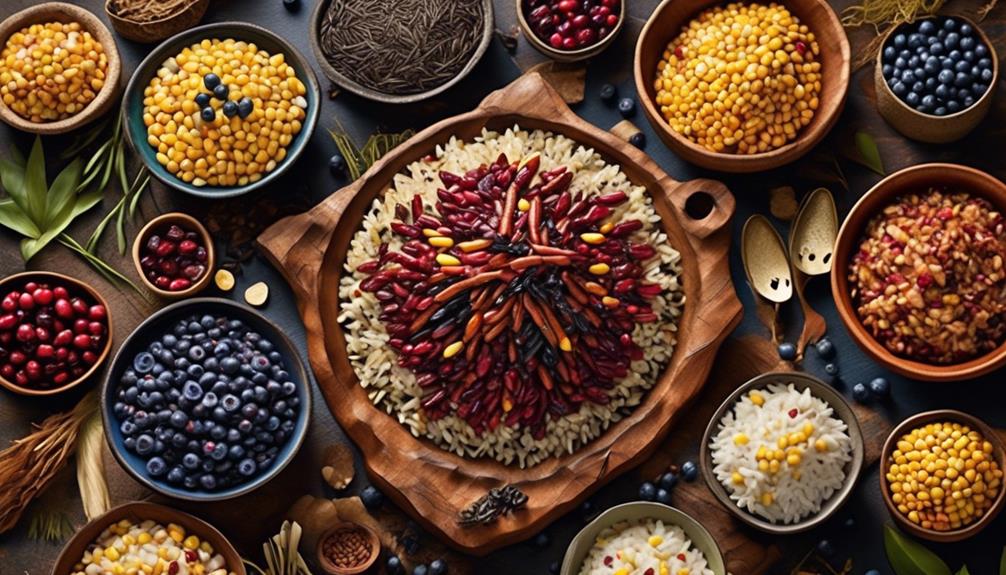
When we come together at our contemporary dining tables, it’s simple to forget about the deep gastronomic legacy that North America possesses.
The foods indigenous to this land are not just sustenance; they are a testament to the diverse and bountiful ecosystems that have sustained indigenous peoples for centuries.
From the sacred trio of the Three Sisters to the fiery kick of chiles and peppers, the culinary landscape of North America is as varied as the land itself.
Join us as we uncover the deep-rooted traditions and flavors that have shaped the indigenous foodways of this continent.
Key Takeaways
- Corn, beans, and squash are the traditional crops that form the cornerstone of many Indigenous North American diets, with each plant serving a specific purpose in their farming practices.
- Wild rice is a staple in the diet of Northern Native communities and holds cultural and nutritional significance, symbolizing spiritual and communal ties in Indigenous communities.
- Berries and fruits, cultivated through traditional methods, reflect the deep connection between Indigenous peoples and the land, ensuring the health of the land and providing a bountiful harvest.
- Chiles and peppers have long been used in Indigenous cuisine, adding depth and complexity to traditional dishes and valued for their medicinal and spiritual properties. Seafood and game are integral elements of the Indigenous North American diet, reflecting the deep connection and respect Indigenous communities have for the environment and its gifts.
The Three Sisters: Corn, Beans, and Squash
The Three Sisters, consisting of corn, beans, and squash, form the cornerstone of many Indigenous North American diets. Traditional farming practices involved planting these three crops together, creating a mutually beneficial system. Corn provides a structure for the beans to climb, while the beans add nitrogen to the soil, benefiting all three plants. Meanwhile, squash spreads along the ground, providing shade to prevent weeds and retaining moisture in the soil. This sustainable and efficient method of farming not only ensured a bountiful harvest but also enhanced the soil's fertility for future crops.
Culinary symbolism is deeply intertwined with the Three Sisters. Beyond their practical agricultural benefits, these crops hold cultural and spiritual significance for many Indigenous communities. They're often referred to as 'sisters' to symbolize the inseparable bond between them, reflecting the interconnectedness of all living things. The Three Sisters also feature prominently in traditional stories and ceremonies, emphasizing their importance in Indigenous culture.
Wild Rice: A Northern Native Staple

A staple in the diet of Northern Native communities, wild rice holds cultural and nutritional significance, reflecting the deep connection between the land and Indigenous food traditions.
Traditional harvesting of wild rice involves a deep understanding of the plant's natural habitat, with hand-harvesting techniques passed down through generations.
The significance of wild rice extends beyond sustenance; it's deeply interwoven with cultural practices and ceremonies, symbolizing spiritual and communal ties.
The grain plays a vital role in Indigenous communities, not only as a dietary staple but also as a means of preserving and passing down traditional knowledge and values.
Wild rice, or manoomin as it's known in Ojibwe, has been an integral part of our cultural identity for centuries.
The careful and respectful harvesting of this grain is a tradition that honors our connection to the land and the teachings of our ancestors.
The cultural significance of wild rice goes far beyond its nutritional value, embodying our heritage and way of life.
As we continue to uphold the tradition of wild rice harvesting, we honor the legacy of our people and the enduring importance of this sacred grain.
Berries and Fruits: Nature's Sweet Offerings
Abundant in the natural landscape, berries and fruits provide a delectable array of nature's sweet offerings. Berry picking is a seasonal tradition that has been passed down through generations. The act of foraging for wild berries, such as blueberries, blackberries, and raspberries, connects us to the land and the traditions of our ancestors. The rich flavors and vibrant colors of these berries are unparalleled, making them a prized part of Indigenous cuisine.
Cultivating fruit using sustainable practices has been a cornerstone of Indigenous agriculture for centuries. Traditional methods, including intercropping and companion planting, have allowed for the cultivation of a variety of fruits, including cherries, plums, and cranberries. These sustainable practices not only ensure the health of the land but also provide a bountiful harvest for communities.
The diverse array of berries and fruits indigenous to North America reflects the deep connection between Indigenous peoples and the land. As we continue to celebrate and honor these natural offerings, it's essential to recognize the traditional knowledge and sustainable practices that have sustained these gifts for generations.
Chiles and Peppers: Spicing Up Indigenous Cuisine
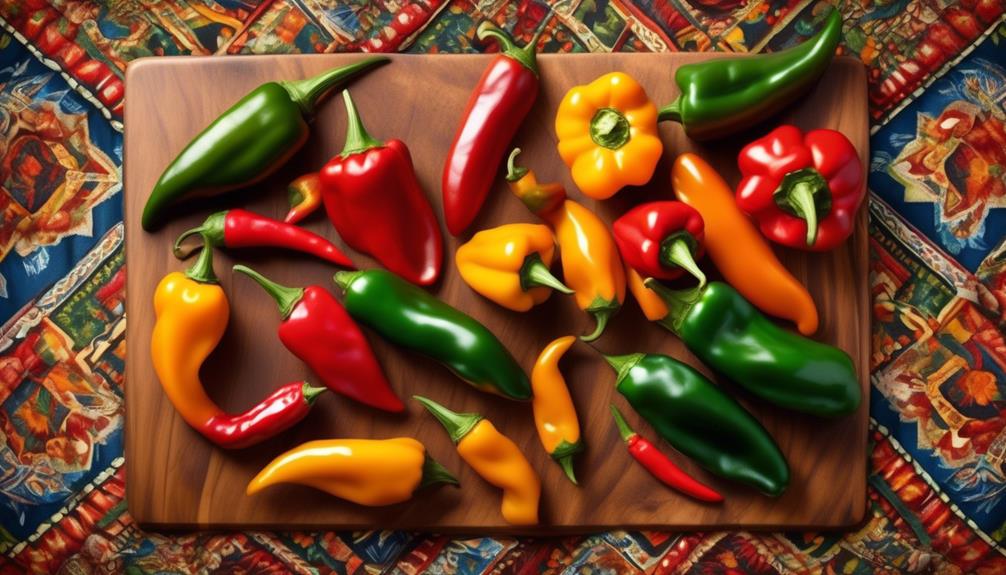
Picking wild berries has been a cherished tradition, and now we're turning up the heat with the addition of chiles and peppers to our Indigenous cuisine. Culinary traditions of North America have long included the use of chiles and peppers, which hold significant historical significance in Indigenous cultures. These flavorful additions not only bring heat but also depth and complexity to our traditional dishes.
Chiles and peppers have been a staple in Indigenous cuisine for thousands of years. They were cultivated and used in various forms, from fresh to dried, and added a unique dimension to the culinary traditions of different Indigenous tribes across North America. The historical significance of chiles and peppers in Indigenous cuisine goes beyond flavor; they were also valued for their medicinal and spiritual properties.
The use of chiles and peppers in Indigenous cuisine has left a lasting impact on the culinary landscape of North America. Today, they continue to be celebrated and incorporated into modern dishes, showcasing the enduring legacy of Indigenous culinary traditions.
Seafood and Game: Sustenance From Land and Water
Sourcing sustenance from both land and water, we've long relied on seafood and game as integral elements of our Indigenous North American diet. Our coastal traditions involve shellfish gathering, a practice deeply rooted in our heritage. From the Pacific Northwest to the Eastern Seaboard, our ancestors skillfully harvested clams, oysters, and mussels, recognizing the bountiful resources provided by the sea.
Hunting techniques, such as tracking game, have been passed down through generations, ensuring the sustainability of our food sources. The art of tracking and hunting deer, elk, bison, and other game animals has been a fundamental aspect of our cultural identity, providing us with nourishment and honoring the natural world.
Our deep connection to the land and water is reflected in the way we gather and hunt for seafood and game, embodying our respect for the environment and the gifts it offers.
Frequently Asked Questions
What Are the Nutritional Benefits of the Indigenous Foods Mentioned in the Article?
The nutritional benefits of indigenous foods are numerous. They offer a rich source of vitamins, minerals, and antioxidants, contributing to overall health and well-being. Culinary techniques such as roasting, steaming, and fermenting help preserve these nutrients.
Understanding the nutritional value of indigenous foods is important for promoting healthy eating habits and preserving traditional culinary practices.
How Have Indigenous North American Communities Traditionally Prepared and Cooked These Foods?
Traditional cooking methods used by indigenous North American communities include techniques such as roasting, boiling, steaming, and fermenting. These methods are integral to preserving the nutritional value and flavor of indigenous foods.
Indigenous food traditions emphasize the use of local, seasonal ingredients and sustainable harvesting practices. By incorporating these cooking methods and traditions, indigenous communities have maintained a deep connection to the land and its bounty for generations.
Are There Any Traditional Rituals or Ceremonies Associated With the Cultivation and Consumption of These Indigenous Foods?
Traditional practices associated with indigenous food cultivation and consumption hold deep cultural significance for our communities. These practices are often intertwined with rituals and ceremonies, reflecting our reverence for the land and the bounty it provides.
Community celebrations and seasonal gatherings centered around these foods serve as a way to honor our heritage and strengthen our connections to our ancestors and the natural world.
How Have the Cultivation and Consumption of These Indigenous Foods Evolved Over Time Within Indigenous Communities?
Over time, the cultivation and consumption of indigenous foods within our communities have evolved, blending traditional practices with modern adaptations.
The evolution of cultivation reflects our cultural significance, preserving ancestral wisdom while embracing innovation.
For instance, the traditional practice of seed saving has transformed into community seed banks, safeguarding our heritage crops.
This metaphor of growth embodies the dynamic nature of our food traditions, rooted in the past, flourishing in the present.
Are There Any Current Efforts to Preserve and Promote the Use of These Indigenous Foods in Modern Cuisine?
Efforts to preserve and promote indigenous foods in modern cuisine are crucial for sustainability.
Through advocacy, we aim to raise awareness and celebrate the rich culinary heritage of North America.
Promoting the use of indigenous foods not only honors tradition but also supports local communities and fosters a deeper connection to the land.
These efforts are essential in preserving cultural identity and promoting a more sustainable and diverse food system.
Conclusion
In conclusion, the rich tapestry of indigenous North American cuisine is like a vibrant mosaic, woven together with the Three Sisters, wild rice, berries, chiles, seafood, and game.
Each ingredient tells a story of resilience, tradition, and connection to the land.
Just like a patchwork quilt, these foods represent the diverse cultures and flavors that make up the beautiful tapestry of North America.
Mary is a passionate writer who brings creativity and a fresh perspective to our team. Her words have the power to captivate and inspire, making her an essential contributor to our content. Mary’s commitment to storytelling and dedication to promoting Indigenous culture ensures that her work touches the hearts of our readers. We’re fortunate to have her as part of our team.
Indigenous
What Is Indigenous Sovereignty
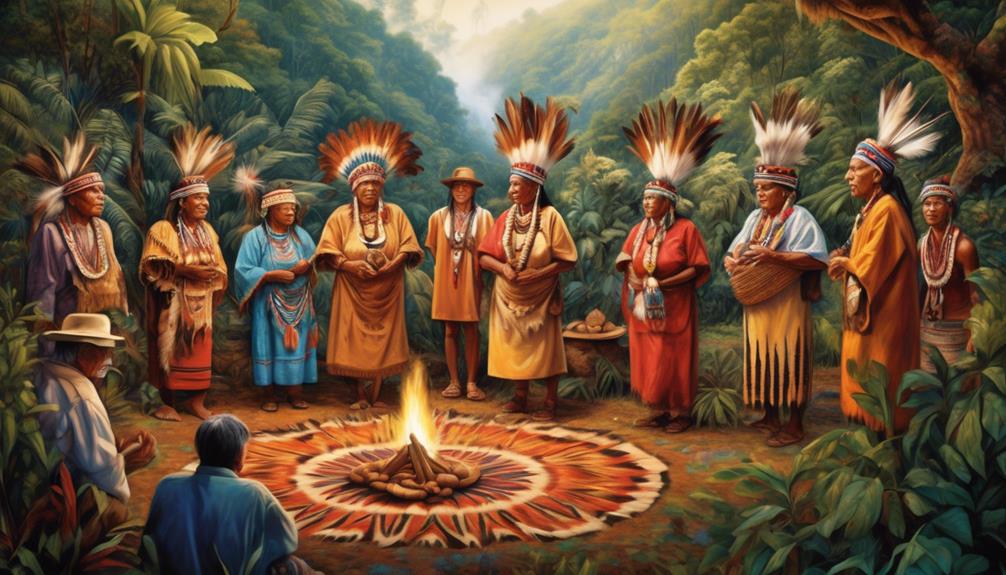
Indigenous sovereignty represents a tapestry crafted from strands of resilience, culture, and autonomy. Its importance goes well beyond the confines of law and politics, capturing the lasting essence of indigenous peoples.
As we explore the multifaceted nature of indigenous sovereignty, it becomes evident that it encompasses not only territorial rights but also the preservation of cultural heritage and the quest for autonomy.
However, the complexities and nuances of indigenous sovereignty require us to navigate through historical struggles, legal complexities, and contemporary challenges.
Join us in unraveling the layers of indigenous sovereignty, understanding its impact, and exploring its relevance in the modern world.
Key Takeaways
- Colonization and oppression have had a significant impact on the autonomy and self-governance of Indigenous communities.
- Legal recognition of Indigenous communities is crucial for affirming their autonomy and self-governance.
- Asserting land rights is fundamental for upholding Indigenous sovereignty and preserving cultural identity.
- Indigenous communities face ongoing challenges such as legal battles over land rights and economic disparities, but continue to advocate for their rights and strive for cultural preservation.
Historical Context of Indigenous Sovereignty
As we delve into the historical context of Indigenous sovereignty, it becomes evident that centuries of colonization and oppression have significantly impacted the autonomy and self-governance of Indigenous communities. The colonial impact on Indigenous sovereignty has been profound, as European powers imposed their own systems of governance, often disregarding or actively suppressing Indigenous forms of self-rule. This has led to a long-standing struggle for Indigenous peoples to maintain their cultural resilience and traditional ways of governance in the face of external pressures.
Despite these challenges, Indigenous communities have demonstrated remarkable cultural resilience, preserving their languages, traditions, and customs throughout generations. The resilience of Indigenous cultures has been a crucial factor in their ongoing assertion of sovereignty and self-determination. It's important to recognize that the impacts of colonization aren't just historical, but continue to affect Indigenous communities today, shaping their ongoing struggles for autonomy and self-governance.
Understanding the historical context of Indigenous sovereignty necessitates acknowledging the enduring effects of colonialism and celebrating the strength and resilience of Indigenous cultures in the face of significant adversity.
Legal Frameworks and Recognition
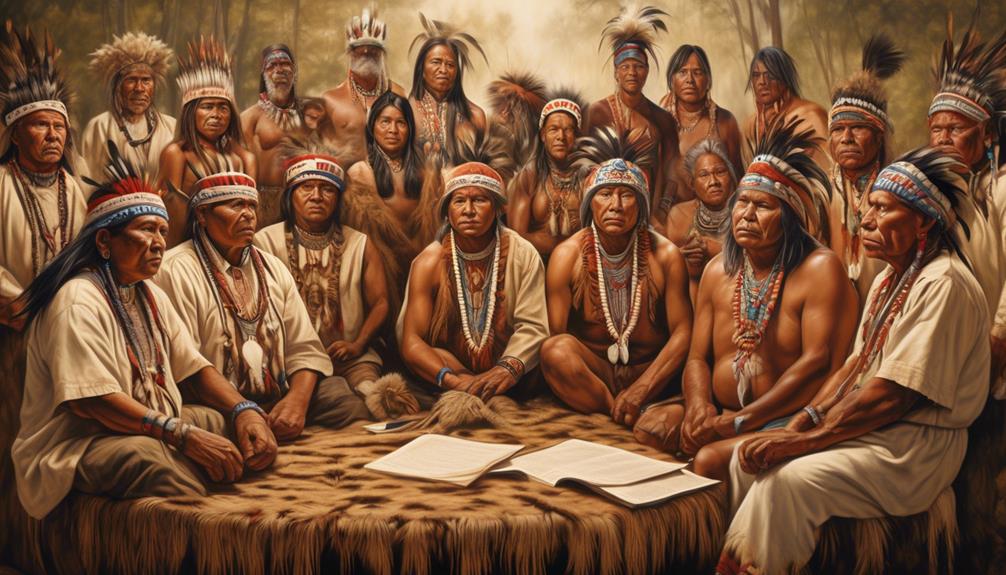
The impact of colonialism on Indigenous sovereignty has spurred the development of legal frameworks and recognition that are crucial for affirming the autonomy and self-governance of Indigenous communities. Legal recognition is fundamental in acknowledging the inherent rights of Indigenous peoples and their authority over their lands and resources. This recognition serves as a cornerstone for the protection and preservation of Indigenous cultures, traditions, and ways of life.
Importance of Legal Recognition
- Self-Determination: Legal recognition empowers Indigenous communities to govern themselves and make decisions that affect their people and territories.
- Land Rights: It provides a basis for asserting land rights and territorial integrity, safeguarding against encroachment and exploitation.
- Cultural Preservation: Recognizing Indigenous legal systems and customs helps safeguard their cultural heritage and traditional knowledge.
The implications of legal frameworks and recognition extend beyond national borders. International implications underscore the significance of respecting Indigenous sovereignty on a global scale, emphasizing the need for collaboration and adherence to international standards and conventions.
Indigenous Sovereignty and Land Rights
Asserting our inherent rights to our ancestral lands and resources is crucial for upholding Indigenous sovereignty and self-governance. Land ownership is fundamental to Indigenous communities' cultural identity, economic self-sufficiency, and overall well-being. Our traditional territories are more than just physical spaces; they're repositories of our history, spirituality, and traditional knowledge. The struggle for Indigenous land rights often intersects with the fight for environmental conservation and sustainable development. Recognizing and respecting our land rights isn't only a matter of justice but also essential for maintaining ecological balance and biodiversity.
The legal recognition of Indigenous land rights is a complex issue that varies widely across different jurisdictions. It often involves navigating historical injustices, conflicting property laws, and competing interests of governmental and corporate entities. Moreover, the concept of land ownership itself may differ significantly between Indigenous customary systems and Western legal frameworks.
As we assert our sovereignty over our traditional territories, it's imperative to establish mechanisms that allow for meaningful co-management and decision-making regarding land use and natural resources. This necessitates a shift towards collaborative governance models that honor Indigenous perspectives and ensure sustainable stewardship of the land.
Challenges and Contemporary Issues
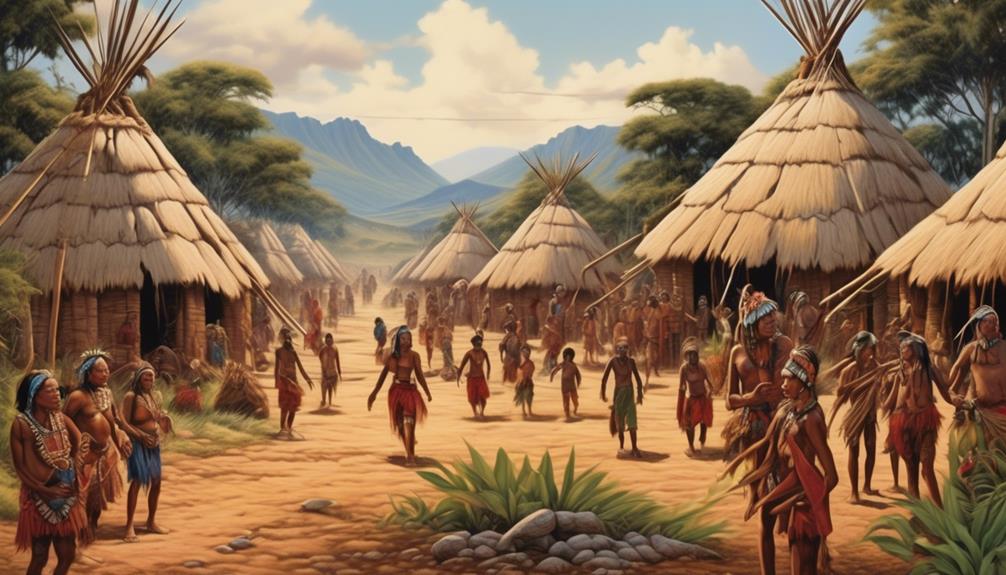
Navigating the complexities of modern legal systems while upholding our inherent rights to our ancestral lands presents significant challenges for Indigenous communities. The contemporary struggles we face encompass a range of issues that impact our cultural preservation and sovereignty. These challenges include:
- Land Disputes: Indigenous communities often face legal battles over land rights, as government entities and corporations seek to exploit natural resources on our ancestral lands without our consent. This poses a threat to our cultural heritage and traditional way of life.
- Political Representation: Despite efforts to advocate for our rights, Indigenous communities often struggle to gain meaningful representation in political decision-making processes. This lack of representation hinders our ability to protect our sovereignty and address the unique challenges we face.
- Economic Inequality: Many Indigenous communities grapple with economic disparities, which are exacerbated by historical injustices and discriminatory policies. This economic inequality undermines our ability to fully engage in cultural preservation efforts and maintain self-sufficiency.
In the face of these challenges, Indigenous communities continue to advocate for their rights, striving to overcome contemporary struggles and preserve their cultural heritage for future generations.
Importance of Indigenous Sovereignty Today
Amidst the complexities of modern legal systems, Indigenous sovereignty stands as a vital cornerstone for the preservation of our ancestral lands and cultural heritage. In today's world, the importance of Indigenous sovereignty cannot be overstated. It is the key to cultural preservation and self-determination for Indigenous communities around the globe.
| Importance of Indigenous Sovereignty Today |
|---|
| Cultural Preservation |
| Indigenous sovereignty is essential for the protection of our cultural practices, languages, and traditional knowledge. It allows us to maintain and pass on our unique ways of life to future generations. |
| Self-Determination |
| Sovereignty empowers Indigenous communities to govern themselves, make decisions about their own affairs, and shape their own futures. It enables us to uphold our traditions and adapt them to modern realities, ensuring our voices are heard in matters that affect us directly. |
Frequently Asked Questions
What Are Some Specific Examples of Indigenous Sovereignty Being Recognized and Respected in Modern Legal Frameworks?
Examples of indigenous sovereignty being recognized and respected in modern legal frameworks include:
- The legal recognition of land rights: This recognition acknowledges the inherent rights of indigenous communities to govern their own lands. It allows them to make decisions about resource management, land use, and development in ways that align with their cultural and traditional practices.
- Environmental protection: Indigenous sovereignty is also recognized in the legal frameworks that protect the environment. These frameworks acknowledge that indigenous communities have a deep connection to the land and possess valuable knowledge and traditional practices that can contribute to sustainable environmental management.
These legal frameworks demonstrate a growing understanding and respect for indigenous sovereignty within the broader legal system. They affirm the rights of indigenous communities to self-govern and make decisions that are in line with their cultural values and traditions. By recognizing and respecting indigenous sovereignty, these legal frameworks contribute to the preservation of indigenous cultures and the protection of the environment.
How Do Indigenous Communities Define and Exercise Their Sovereignty in Relation to Natural Resources and Environmental Protection?
In defining and exercising their sovereignty, indigenous communities display a deep commitment to environmental stewardship and resource management. By drawing upon traditional knowledge and practices, they assert their rights to protect and sustainably utilize natural resources.
This approach not only preserves the environment but also safeguards the cultural and spiritual significance of these resources. Indigenous sovereignty in this context reflects a holistic and interconnected approach to environmental preservation and community well-being.
What Are Some Common Challenges That Indigenous Communities Face in Asserting Their Sovereignty and Maintaining Their Land Rights?
In asserting our sovereignty and maintaining our land rights, indigenous communities commonly face challenges. These challenges include encroachment on our territories, lack of recognition of our traditional governance structures, and the threat of cultural assimilation.
These challenges hinder our ability to preserve our cultural heritage and protect our lands. Without recognition of our sovereignty, encroachment on our territories becomes more likely, leading to the loss of valuable resources and sacred sites. Additionally, the lack of recognition of our traditional governance structures undermines our ability to self-govern and make decisions that are in line with our cultural values and practices.
Furthermore, the threat of cultural assimilation poses a significant risk to our way of life. When our cultural practices and traditions are not respected or valued, they become at risk of being lost. This erosion of our cultural heritage not only affects our communities but also contributes to the loss of diversity and knowledge for society as a whole.
Therefore, it is crucial to address these issues to uphold our rights and ensure the continuation of our way of life. By recognizing and respecting our sovereignty, supporting our traditional governance structures, and promoting the preservation of our cultural heritage, we can work towards a more just and inclusive society for all.
How Do Indigenous Sovereignty and Self-Governance Intersect With Contemporary Issues Such as Economic Development and Healthcare Access?
Incorporating economic development, cultural preservation, healthcare access, and land rights, we see how indigenous sovereignty and self-governance intersect with contemporary issues.
Economic development may reflect the autonomy of indigenous communities, while healthcare access and cultural preservation are vital for their well-being.
Land rights are fundamental to their self-determination.
These intersections demonstrate the complex and interconnected nature of indigenous sovereignty and self-governance in addressing contemporary challenges.
In What Ways Does the Assertion of Indigenous Sovereignty Contribute to the Overall Diversity and Resilience of Global Governance Systems?
In the grand scheme of global governance, the assertion of indigenous sovereignty enriches diversity and resilience.
Legal recognition empowers indigenous communities to protect natural resources and advocate for environmental protection.
Their unique perspectives and traditional knowledge contribute to more holistic and sustainable approaches, enhancing the overall effectiveness of global governance systems.
Recognizing and honoring indigenous sovereignty fosters a more inclusive and robust framework for addressing complex global challenges.
Conclusion
In conclusion, indigenous sovereignty is a crucial and ongoing struggle for self-determination and the protection of land rights. It's a complex and multifaceted issue that requires recognition, respect, and support from governments and society.
Investigating the truth of the theory that indigenous sovereignty is essential for environmental conservation and sustainable development can provide a deeper understanding of its importance in today's world.
Mary is a passionate writer who brings creativity and a fresh perspective to our team. Her words have the power to captivate and inspire, making her an essential contributor to our content. Mary’s commitment to storytelling and dedication to promoting Indigenous culture ensures that her work touches the hearts of our readers. We’re fortunate to have her as part of our team.
Indigenous
How to Celebrate Indigenous People's Day

We recognize that there might be some uncertainty about the proper way to observe Indigenous People’s Day, particularly for those who are not familiar with this celebration.
However, there are meaningful ways we can honor and recognize the rich cultures and histories of Indigenous peoples. From supporting Indigenous-owned businesses to participating in traditional ceremonies, there are a variety of ways to show respect and appreciation.
But there's more to it than just these ideas. There are numerous meaningful ways to celebrate Indigenous People's Day that can make a positive impact, and we're here to guide you through them.
Key Takeaways
- Actively support Indigenous-owned businesses to honor and uplift their contributions to communities and economies.
- Seek permission and guidance from community leaders and elders before attending traditional ceremonies.
- Explore museums showcasing Indigenous art, artifacts, and historical narratives to learn about Indigenous history and contributions.
- Attend powwows, tribal festivals, and other community events to glimpse Indigenous traditions and foster connections with Indigenous communities.
Support Indigenous-owned Businesses
Let's actively support Indigenous-owned businesses to honor and uplift their contributions to our communities and economies. By doing so, we can help preserve and promote Indigenous art, traditions, and cultural workshops. When we invest in Indigenous-owned businesses, we aren't only supporting the economic prosperity of Indigenous communities but also the preservation of their heritage and traditions.
These businesses often offer unique products such as handcrafted Indigenous art, traditional clothing, jewelry, and artwork that hold deep cultural significance.
Engaging with Indigenous-owned businesses also provides an opportunity to learn more about Indigenous cultures through cultural workshops and events. These experiences offer valuable insights into the rich traditions, art forms, and craftsmanship of Indigenous communities. By actively seeking out and participating in these cultural workshops, we can gain a deeper understanding and appreciation for the diverse cultures that enrich our society.
Supporting Indigenous-owned businesses is a meaningful way to contribute to the empowerment and self-determination of Indigenous communities. It fosters economic independence and strengthens the cultural fabric of our society.
Let's actively seek out and support Indigenous-owned businesses to celebrate and honor the invaluable contributions they make to our communities.
Participate in Traditional Ceremonies
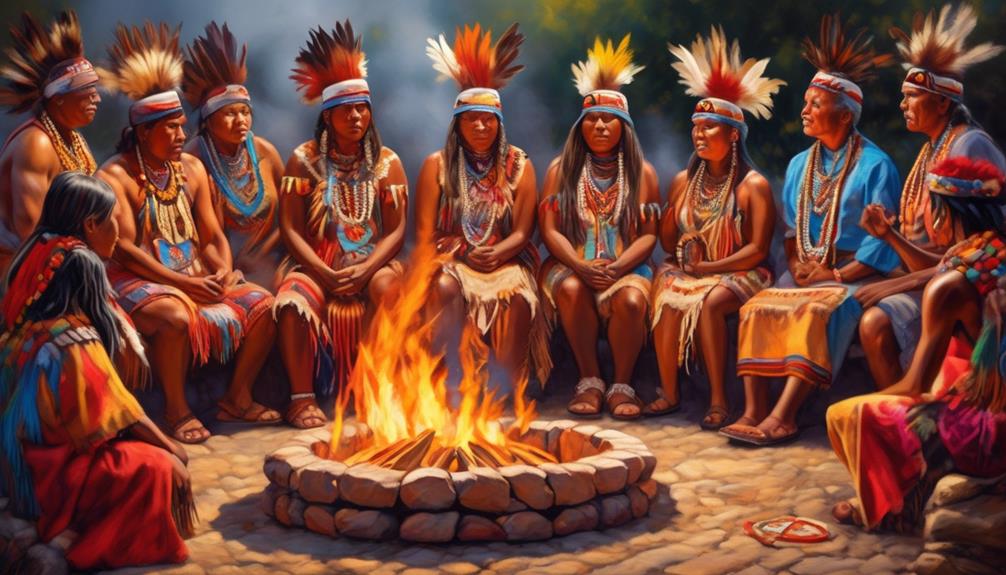
To further engage with and honor Indigenous cultures, actively participating in traditional ceremonies offers an opportunity to immerse ourselves in the rich traditions and spiritual practices of Indigenous communities. Traditional dances and sacred rituals provide a window into the cultural and spiritual significance of Indigenous peoples. Here are some ways to respectfully participate in traditional ceremonies:
- Seek Permission and Guidance: Before attending any traditional ceremony, it's crucial to seek permission from the community leaders and elders. Understanding the protocols and guidelines ensures that we approach the ceremony with respect and mindfulness.
- Embrace the Experience: Participating in traditional ceremonies requires an open mind and willingness to learn. Embrace the experience with humility and an eagerness to understand the cultural significance behind each ritual and dance.
- Respect Sacred Spaces: Traditional ceremonies often take place in sacred spaces. It's important to treat these locations with reverence, honoring their spiritual significance and maintaining their sanctity.
- Express Gratitude: After participating in a traditional ceremony, it's respectful to express gratitude to the community for allowing us to share in their cultural practices. Showing appreciation fosters positive relationships and acknowledges the value of Indigenous traditions.
Engaging in traditional ceremonies allows us to gain a deeper understanding and appreciation for Indigenous cultures while honoring their spiritual heritage.
Learn About Indigenous History and Contributions
Exploring the rich history and invaluable contributions of Indigenous peoples provides a profound opportunity to deepen our understanding of their enduring legacy. To learn about Indigenous history and contributions, we can start by exploring museums that showcase Indigenous art, artifacts, and historical narratives. These museums offer a window into the diverse cultures, traditions, and experiences of Indigenous communities, allowing us to appreciate their rich heritage.
Furthermore, reading literature authored by Indigenous writers can offer valuable insights into their history and contributions. Works of fiction, non-fiction, and poetry by Indigenous authors provide a unique perspective on their experiences, struggles, and triumphs. These literary works can help us gain a deeper appreciation for the complexities and resilience of Indigenous cultures.
Engage in Community Events and Activities

Engaging in community events and activities allows us to connect with Indigenous cultures and traditions in meaningful ways, fostering mutual understanding and appreciation. Participating in these gatherings provides an opportunity to honor and learn from the rich history and knowledge of Indigenous communities.
- Community Gatherings: Attending powwows, tribal festivals, and other community events can offer a glimpse into Indigenous traditions, including music, dance, arts, and storytelling.
- Cultural Workshops: These workshops provide a hands-on experience to learn traditional crafts, cooking, and language, offering a deeper understanding of Indigenous lifeways.
- Traditional Celebrations: Joining in celebrations, such as sacred ceremonies or seasonal festivals, can provide insight into the spiritual and cultural practices of Indigenous peoples.
- Community Service: Volunteering for community-driven initiatives can foster meaningful connections and contribute positively to Indigenous communities, promoting solidarity and mutual respect.
Advocate for Indigenous Rights and Recognition
Advocating for the rights and recognition of Indigenous peoples is crucial for promoting social justice and equity in our communities. As advocates, we must actively work towards ensuring that Indigenous rights are respected and upheld. This involves supporting Indigenous-led movements, educating others about the historical and ongoing injustices faced by Indigenous communities, and advocating for policy changes that prioritize Indigenous sovereignty and self-determination.
Recognizing Indigenous rights means acknowledging the inherent sovereignty and autonomy of Indigenous nations. It involves advocating for the protection of Indigenous lands, natural resources, and sacred sites. Furthermore, recognition also encompasses supporting Indigenous languages, cultures, and traditions, and affirming the right of Indigenous peoples to practice and revitalize their ways of life without interference.
In advocating for Indigenous rights and recognition, it's essential to center Indigenous voices and perspectives, amplify their calls for justice, and actively seek opportunities to stand in solidarity with Indigenous communities. By doing so, we contribute to a more just and inclusive society where the rights and contributions of Indigenous peoples are respected and celebrated.
Frequently Asked Questions
How Can I Respectfully Participate in Traditional Ceremonies Without Appropriating Indigenous Culture?
Respectful participation in traditional ceremonies involves learning about the cultural significance, obtaining proper permissions, and showing genuine respect.
It's about cultural appreciation, understanding the historical and spiritual roots, and engaging ethically.
We can seek guidance from indigenous leaders, educate ourselves on the traditions, and honor their sacred practices.
Cultural sensitivity and ethical engagement are crucial in fostering meaningful and respectful interactions.
It's essential to approach these ceremonies with humility and a desire to learn and understand.
What Are Some Ways to Support Indigenous Businesses That May Not Be Widely Known or Advertised?
Supporting indigenous businesses is crucial for economic empowerment. We actively seek out and patronize lesser-known indigenous businesses, appreciating their unique offerings.
Culturally respectful participation involves understanding the significance of traditional practices and engaging with them in a respectful and informed manner.
Are There Any Specific Historical Events or Contributions by Indigenous People That Are Often Overlooked or Not Widely Known?
Unrecognized achievements and cultural preservation are vital to acknowledge.
Many significant historical events and contributions by indigenous people often go overlooked. Their impact on various fields, from art and literature to science and environmental stewardship, is profound yet not widely known.
It's crucial to recognize and celebrate these contributions, as they enrich our collective history and provide valuable insights into cultural diversity and resilience.
What Are Some Ways to Engage in Community Events and Activities That May Not Be Widely Publicized?
Engaging events and community activities can often go unnoticed. However, we can seek out local organizations, cultural centers, or social media groups that promote Indigenous People's Day events.
Attending powwows, art exhibits, or traditional storytelling sessions can provide insight into Indigenous cultures and histories. Additionally, volunteering at or donating to Indigenous-led organizations can help support their initiatives.
How Can I Advocate for Indigenous Rights and Recognition in My Local Community or on a Larger Scale?
Advocating for indigenous rights and recognition in our local community or on a larger scale involves various strategies.
We focus on promoting indigenous representation, implementing advocacy strategies, fostering cultural sensitivity, and engaging with the community.
It's a journey of education, empathy, and action. By amplifying indigenous voices, respecting their traditions, and supporting their causes, we strive to create a more inclusive and equitable society.
Conclusion
Let's honor Indigenous Peoples Day by:
- Supporting Indigenous-owned businesses
- Participating in traditional ceremonies
- Learning about their history and contributions
- Engaging in community events
- Advocating for their rights and recognition
Let's celebrate their:
- Strength
- Resilience
- Rich culture
Let's stand in solidarity with Indigenous communities and work towards a future that:
- Respects and uplifts their voices
Together, let's celebrate and honor Indigenous Peoples Day in a meaningful and impactful way.
Mary is a passionate writer who brings creativity and a fresh perspective to our team. Her words have the power to captivate and inspire, making her an essential contributor to our content. Mary’s commitment to storytelling and dedication to promoting Indigenous culture ensures that her work touches the hearts of our readers. We’re fortunate to have her as part of our team.
Indigenous
Which Indigenous Group Was Concentrated in Mexico by the Time the Spaniards Arrived
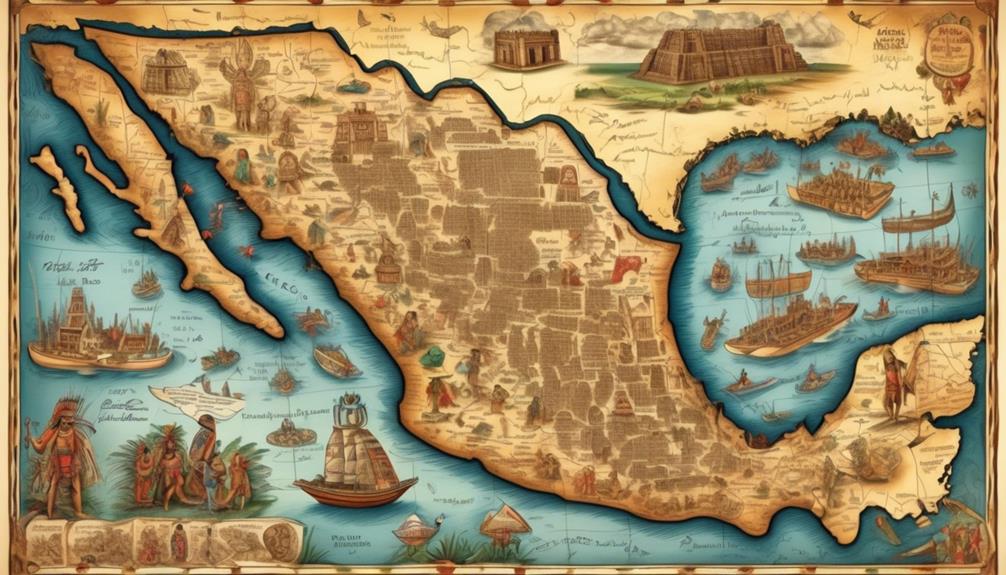
When considering the native communities in Mexico at the time of the Spanish conquest, a single group emerges as a prevailing power in the area. The authority and sway of this community had a profound effect on the Mexican landscape during that period.
As we explore the dynamics of this indigenous group and their interactions with the Spaniards, a clearer understanding of the historical context begins to emerge. But who were they, and what made them so influential? These questions drive us to unravel the complex tapestry of Mexico's indigenous history, shedding light on a pivotal moment in time.
Key Takeaways
- The indigenous group that was concentrated in Mexico by the time the Spaniards arrived was the Aztecs.
- The Aztecs had established a vast empire known as the Aztec Empire and held significant political and religious authority.
- Aztec society was stratified into nobles, commoners, serfs, and slaves, with the nobles holding political and economic power.
- The Aztecs had complex religious practices and beliefs, with a pantheon of deities and elaborate ceremonies held to honor the gods.
Arrival of the Spaniards in Mexico
When the Spaniards arrived in Mexico in the early 16th century, their impact on the indigenous groups was profound and far-reaching. Spanish colonization brought about significant changes in the social, economic, and political structures of the indigenous societies.
The imposition of Spanish rule led to the exploitation of indigenous labor, the introduction of new diseases, and the forced conversion to Christianity. The indigenous populations were subjected to harsh treatment, land dispossession, and cultural assimilation under the encomienda system, which further exacerbated their suffering.
In response to the Spanish colonization, indigenous groups developed various resistance strategies to protect their autonomy and cultural heritage. Some communities engaged in armed resistance, such as the famous Aztec rebellion against the Spanish conquistadors. Others employed more subtle tactics, including maintaining traditional practices in secret and preserving their languages and belief systems.
Additionally, some indigenous leaders collaborated with the Spaniards strategically to safeguard their people's interests.
Power and Influence of the Aztecs
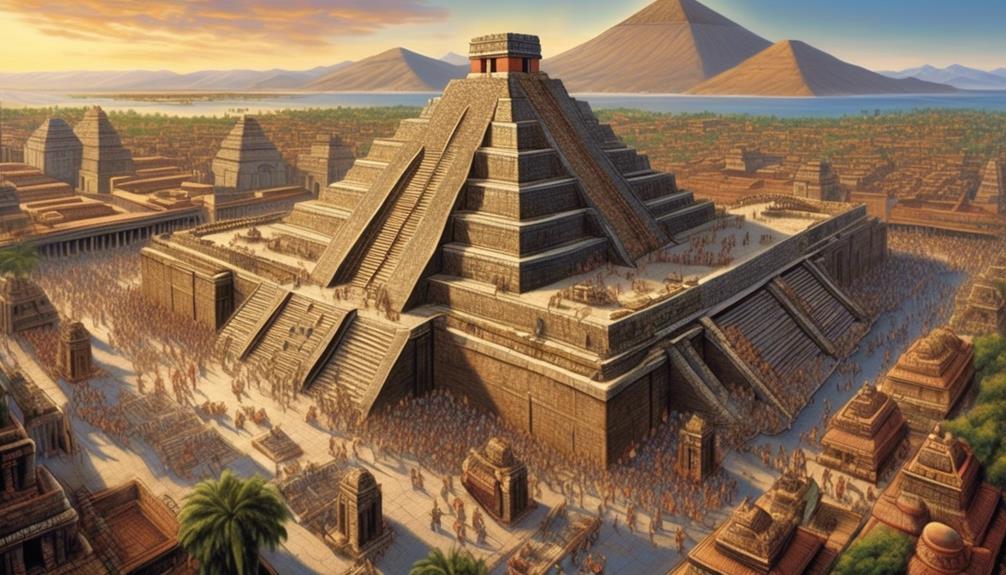
The Aztecs, a powerful and influential indigenous group in Mexico, wielded significant political and religious authority before the arrival of the Spaniards. At the zenith of their power, the Aztecs established a vast empire known as the Aztec Empire, encompassing a large part of Mesoamerica. This empire was characterized by a complex system of governance, with a hierarchical structure that allowed the Aztec rulers, known as tlatoani, to exert control over a diverse range of territories and peoples. The Aztec society was deeply ingrained with religious practices, and the rulers held immense religious authority, often serving as intermediaries between the people and the gods.
The Aztecs also boasted remarkable cultural achievements, particularly in the fields of architecture, art, and agriculture. Their capital city, Tenochtitlan, was a marvel of urban planning and engineering, built on an island in Lake Texcoco. The Aztecs constructed intricate networks of canals, causeways, and floating gardens, showcasing their advanced understanding of hydraulic engineering. Additionally, Aztec art, characterized by intricate designs and vivid colors, reflected their rich mythology and religious beliefs.
The Aztecs' cultural legacy continues to captivate and inspire modern audiences, serving as a testament to their enduring influence in the region.
Aztec Society and Governance
With the Aztecs' significant political and religious authority in mind, we can now explore the structure of Aztec society and governance.
The Aztec society was stratified, consisting of nobles, commoners, serfs, and slaves. At the top were the nobles, including the emperor, military leaders, and high-ranking priests, who held significant political and economic power. Below them were the commoners, who were artisans, merchants, and farmers. The lower strata included serfs who worked the land and slaves who were often prisoners of war. This social structure was tightly intertwined with the Aztec economy, which was primarily based on agriculture, tribute, and trade. The economy was largely controlled by the state, with tribute being collected from conquered territories and redistributed among the ruling class.
In terms of governance, the Aztecs had a complex system that combined elements of monarchy, aristocracy, and theocracy. The emperor held ultimate authority, but he was supported by a council of nobles and high-ranking priests who helped administer the empire. The governance structure was also closely linked to the religious practices of the Aztecs, with many aspects of governance being intertwined with religious rituals and beliefs. This holistic approach to governance and society was a defining feature of Aztec civilization.
Aztec Religious Practices
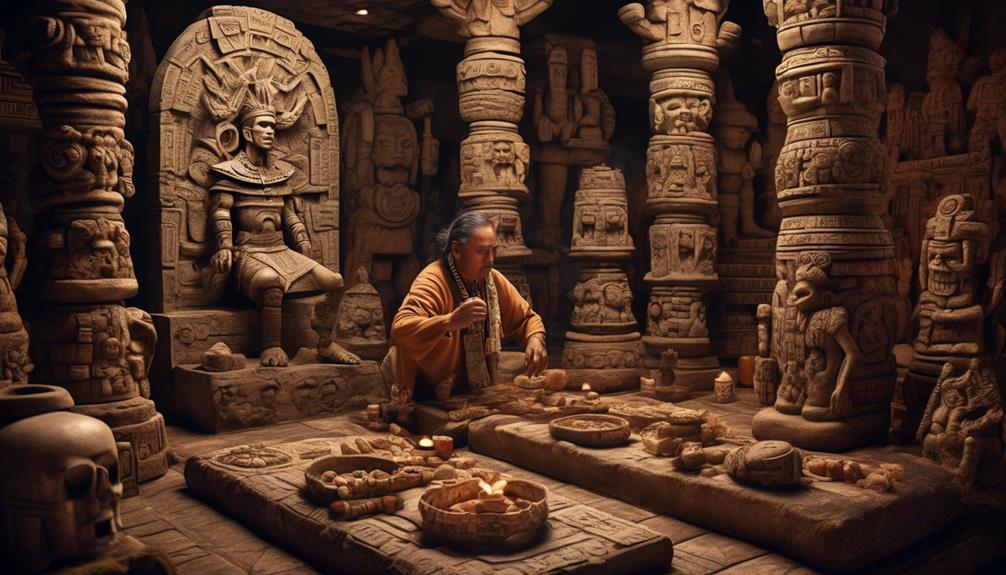
Evident throughout Aztec society, religious practices played a central role in shaping the cultural and spiritual life of the people.
- Spiritual Beliefs: The Aztecs believed in a complex pantheon of deities, each associated with different aspects of life and the natural world. Their spiritual beliefs were deeply intertwined with their everyday existence, influencing everything from agriculture to warfare. The sun god, Huitzilopochtli, held particular significance as the patron deity of the Aztecs, symbolizing power, warfare, and the sun's vital energy.
- Ceremonies: Aztec religious ceremonies were elaborate and diverse, often involving intricate rituals and vibrant performances. These ceremonies were held at specific times throughout the year to honor the gods and seek their favor. The Great Temple in the heart of Tenochtitlan was the center of these religious activities, where priests conducted ceremonies such as the New Fire Ceremony, which symbolized the renewal of the world.
- Ritual Sacrifices and Symbolism: Central to Aztec religious practices were ritual sacrifices, viewed as essential for maintaining the cosmic balance and ensuring the gods' benevolence. Symbolism played a crucial role in the offerings, with different sacrifices serving as potent symbols of devotion and renewal within the Aztec belief system.
Spanish Conquest and Aztec Resistance
Amidst the fervent upheaval sparked by the Spanish Conquest, Aztec resistance permeated the fabric of their society, embodying a steadfast determination to preserve their cultural heritage and sovereignty.
The Spanish conquest of the Aztec Empire in the early 16th century brought about a tumultuous clash of civilizations. The Aztec resistance was multi-faceted, encompassing military, political, and cultural strategies.
Military leaders like Cuauhtémoc fiercely defended their land, and even after the fall of Tenochtitlan, the Aztecs continued to resist Spanish rule through guerrilla warfare.
Politically, some nobles sought to maintain a degree of autonomy under Spanish colonial rule, negotiating privileges and land rights.
Furthermore, the resistance extended to the preservation of Aztec cultural practices and beliefs, albeit often in syncretism with Catholicism.
This resistance, however, was met with severe repression by the Spanish, leading to immense loss of life and cultural heritage.
The resilience of the Aztec people in the face of the Spanish conquest and their enduring resistance serves as a testament to their unwavering commitment to their civilization.
Frequently Asked Questions
What Other Indigenous Groups Besides the Aztecs Were Present in Mexico at the Time of the Spanish Arrival?
We know that besides the Aztecs, the Mayan civilization and Olmec culture were present in Mexico at the time of the Spanish arrival.
The indigenous resistance and population diversity showcased the rich tapestry of indigenous groups in Mexico.
This context illuminates the complexities of the indigenous landscape during that period and adds depth to our understanding of the indigenous experience in Mexico at that time.
How Did the Arrival of the Spaniards Impact Indigenous Groups Other Than the Aztecs?
The arrival of the Spaniards had a significant impact on indigenous groups other than the Aztecs. It led to a disruption of traditions, but also prompted the formation of new alliances and adaptation to the changing circumstances.
Despite the challenges, indigenous communities displayed resilience in the face of cultural and societal changes. Their ability to adapt and form new alliances showcases the strength and resourcefulness of these diverse groups during this transformative period.
What Were the Cultural and Religious Practices of Indigenous Groups in Mexico Besides the Aztecs?
We can explore the cultural practices and religious beliefs of indigenous groups in Mexico besides the Aztecs. Their diverse traditions and customs, including religious ceremonies, agricultural rituals, and artistic expressions, reflected their deep connection to the land and spiritual beliefs.
The Spanish arrival significantly impacted the diversity and population changes, leading to indigenous resistance and cultural assimilation.
Understanding these varied cultural practices and beliefs highlights the rich tapestry of indigenous heritage in Mexico.
How Did Indigenous Groups in Mexico Resist Spanish Conquest and Colonization?
We'll explore indigenous resistance and cultural preservation in Mexico during Spanish conquest and colonization.
Indigenous groups utilized various strategies, such as armed resistance, cultural adaptation, and preservation of traditions, to resist Spanish influence.
Some groups, like the Maya and Zapotec, maintained their cultural practices and language, while others, like the Yaqui and Mixtec, engaged in armed resistance.
This demonstrates the diverse ways indigenous communities in Mexico resisted and preserved their culture amidst Spanish colonization.
What Impact Did the Spanish Conquest Have on the Overall Population and Diversity of Indigenous Groups in Mexico?
The Spanish conquest had a significant impact on the overall population and diversity of indigenous groups in Mexico. Population changes were drastic due to disease, warfare, and forced labor. This led to a decline in the indigenous population.
Additionally, the Spanish colonization and imposition of their culture resulted in the suppression and assimilation of various indigenous groups, leading to a loss of diversity.
The lasting effects of these actions continue to shape Mexico's indigenous population today.
Conclusion
In conclusion, the arrival of the Spaniards in Mexico marked a significant shift in the power dynamics of the region. The Aztecs, a powerful and influential indigenous group, were concentrated in Mexico at the time of the Spanish arrival. Despite their resistance, the Aztecs eventually succumbed to Spanish conquest.
It's estimated that the population of the Aztec empire at the time of the Spanish arrival was around 5-6 million people, making them one of the largest and most advanced civilizations in the Americas.
Mary is a passionate writer who brings creativity and a fresh perspective to our team. Her words have the power to captivate and inspire, making her an essential contributor to our content. Mary’s commitment to storytelling and dedication to promoting Indigenous culture ensures that her work touches the hearts of our readers. We’re fortunate to have her as part of our team.
-

 Culture1 month ago
Culture1 month agoUnderstanding Aboriginal Totem Significance
-

 Torres Strait Islanders4 weeks ago
Torres Strait Islanders4 weeks agoSacred Healing: Discovering Indigenous Health Secrets
-

 Torres Strait Islanders4 weeks ago
Torres Strait Islanders4 weeks agoCultural Vitality: Indigenous Health Tips
-

 Torres Strait Islanders4 weeks ago
Torres Strait Islanders4 weeks agoEmbrace Indigenous Wisdom: Top Well-Being Products
-

 Torres Strait Islanders4 weeks ago
Torres Strait Islanders4 weeks agoHolistic Health: Indigenous Wellness Explored
-

 Torres Strait Islanders4 weeks ago
Torres Strait Islanders4 weeks agoIndigenous Health Products Guide for Wellness
-

 Torres Strait Islanders4 weeks ago
Torres Strait Islanders4 weeks agoHealing from the Heart: Indigenous Wellness Goods
-

 Torres Strait Islanders4 weeks ago
Torres Strait Islanders4 weeks agoNature’s Wisdom: Indigenous Well-Being Remedies















